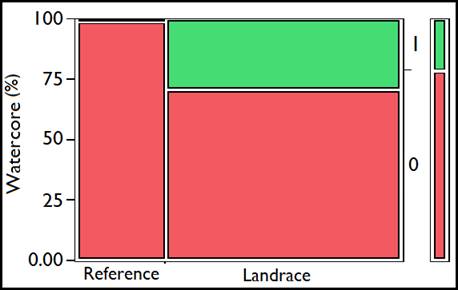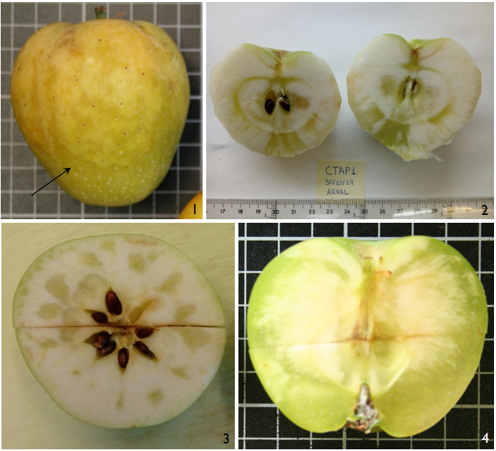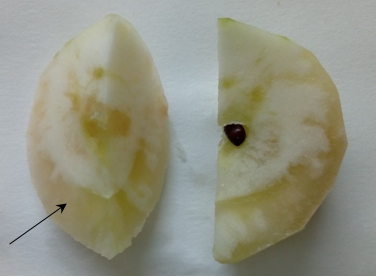INTRODUCTION
Watercore, less known as vitrification, is a translucent or glassy texture in the pulp of the apple (Figure 1). According to Beaudry (2014), Paul Sorauer performed the first published description of this phenomenon in apples in 1886. He described it as a glassy flesh, which was somewhat distinctly sweeter, firmer, with less intercellular air and starch, smelling differently, but also differenced for browning quicker than the unaffected tissue (Beaudry, 2014). Although watercore has been studied in apples, this characteristic has also been identified in peach (Prunus persica (L.) Stokes)(Yamane et al., 2020), pear (Pyrus spp.) (Liu et al., 2021) and mangosteen (Garcinia mangostana L.) (Matra et al., 2019).
The vitreous appearance is due to an invasion of a liquid rich in sorbitol. Sorbitol is polyhydric sugar alcohol synthetized from glucose by hydrogenation. This liquid fills the intercellular spaces, which are normally occupied by air (Beaudry, 2014; Liu et al., 2021). Vitrification is currently considered a defect in fruit crops, alleging that a deficiency of calcium in the soil might be the main cause (Calvo and Candan, 2013), being problems in storage one of the most negative consequences (Saquet, 2020). Nevertheless, susceptibility to watercore also depends on the cultivar, cultural practices, disorders in the water regime, contrasts in temperature, high radiation, and an unbalanced ratio source to sink ratio (Beaudry, 2014). As apples are one of the major temperate crops (Pereira-Lorenzo et al., 2018), there exist many techniques to detect watercore such as light transmission, infrared spectroscopy, thermography, nuclear magnetic resonance, X-ray computed tomography, and even fruit density (Beaudry, 2014; Huang et al., 2020).
Although this defect is important in crops and depends on the cultivar, international authorities such as the International Union for the Protection of Plant Varieties (UPOV, 2018) does not include this characteristic in their manual. In addition, research published on apple landraces is not considering watercore, although the great effort done on phenotyping. Some examples of those works are the one from India (Dolker et al., 2021) and from Greece (Ganopoulos et al., 2018).
Among other purposes, research in traditional cultivars is oriented towards the characteristics’ detection of agronomic interest, sensory evaluation, and ultimately, their possible commercialization as in the case of the ‘Pero de Ceheguín’ (Martínez et al., 2020). There is a European legal framework favourable to the use of local agricultural resources through the Rural Development (UE Regulation n º1305/2013) and labelling on quality regimes (UE Regulation n º1151/2012). The legal framework is manifested in the product with a seal that guarantees superior characteristics compared to a general set of products of the same type. As a result, there is the Protected Designation of Origin (PDO) ‘Reineta del Bierzo’ and the Protected Geographical Indication (PGI) ‘Poma de Girona’. These two products added in 2017 an economic value in the destination market of more than three and a half million euros (MAPA, 2020). Furthermore, ‘Esperiega de Ademuz’, ‘Pero de Ceheguín’, and ‘Pero de La Hiruela’ are also some apple cultivars with certain rename in Spain (specially the first one), but they are not enjoying any international seal yet.
The aim of this research is to analyse the presence and extent of watercore in traditional cultivars from the region of Madrid (Spain) to consider this characteristic in both, germplasm characterisation, and in sensorial analysis.
MATERIAL AND METHODS
A set of 463 apples from 51 trees belonging to 20 apple landraces from rural regions of Madrid Spain (Table 1) were evaluated with 178 apples from 18 references (Table 2) for the ‘watercore’ trait. Apple trees belong to several rural areas that belong to the region of Madrid (Guadarrama mountain range and the Tagus Basin River). The Guadarrama area is 1.200 m a.s.l. on average, although it can reach 2.000 m a.s.l., with a temperate climate that still retains some Mediterranean traits from the surrounding such as hot summers and summer drought. Besides, their soils are composed of granites, slates, and schists, which gives rather an acidic pH. On the other hand, the Tagus area is around 450-700 m a.s.l., with a typical Mediterranean climate. Soils on this area are quaternary alluvial terraces with detritic materials, margous and calcareous, with a basic pH.
Table 1. Number of apples sampled by landrace.
| Landrace | Apples | Landrace | Apples | |
|---|---|---|---|---|
| Agridulce | 10 | Pero gordo | 15 | |
| Amarillo de el Paular | 24 | Pero pardo | 37 | |
| Camueso | 35 | Pero real | 28 | |
| Camueso tardío | 8 | Rabudas | 0 | |
| Camueso temprano | 10 | Reineta | 35 | |
| De Chapa | 30 | Rojillo | 9 | |
| De Rosa | 15 | Rojillo temprano | 4 | |
| Del Ortel | 10 | Rojo | 34 | |
| Esperiega | 11 | San Felipe | 0 | |
| Hojancas | 33 | Temprano | 5 | |
| Pepita de melón | 62 | Verde Doncella | 10 | |
| Pero de Aragón | 38 | Total | 463 |
Table 2. Number of apples sampled by landrace.
| Reference | Apples |
|---|---|
| Fuji | 30 |
| Gala | 48 |
| Golden | 30 |
| Granny Smith | 20 |
| Reineta Blanca | 25 |
| Verde Doncella | 25 |
| Total | 178 |
The cultivars are conserved in a regional collection. As this germplasm bank is located in the area of the Tagus basin, the soil of the experimental station is a calcareous Fluvisol with a pH around 8.5 and a calcium concentration around 23mEq/100g in the first 90cm. As the climate from the collection is Mediterranean, trees were irrigated from May to September every two weeks due to the existence of droughts during the summer. Apples were collected when ripening, during September-October 2016 to 2019 and preserved at around 4 - 7ºC until characterisation, which was performed in the following days or weeks. Apple ripening was considered achieved after skin colour turns into red, yellow or light green, depending on the cultivar.
As we did not find any similar method for this trait in bibliography, in this research, we considered watercore as a dichotomous character (absence/presence) with a binary output (0 and 1, respectively); it was evaluated by visual inspection through two cuts in each apple, one parallel to its pedicel and other perpendicular to the first cut. Apples were evaluated during the following days after harvested to prevent apples from spoiling.
In this descriptive analysis, the central value considered for the chi-squared test (𝝌2) was the mode, and the significance level (α) was set at 0.05. This statistical analysis was run with JMP 9 software (SAS, 2019), and graphic outputs were processed with Inkscape (Inkscape Project, 2020).
RESULTS AND DISCUSSION
A vitreous texture was observed in 137 apples (21% out of 641 samples, Figure 2). Nevertheless, this percentage raised to 29% considering only traditional landraces, as no references shown this character. Only one ‘Verde Doncella’ from references shown watercore. Although this cultivar is considered as a reference in this study, ‘Verde Doncella’ is a Spanish traditional cultivar (Arnal et al., 2020). In consequence, there existed significant differences between both type of cultivars, as χ² was 92.155 (P<0.0001; Figure 2 ).

Figure 2. Contingency table between types of cultivar. 0, Red, no watercore; 1, green, watercore presence. The larger the green square, the more watercore counted.
This vitreous texture was seen in all parts of the pulp of the fruit as we noted vitreous texture intrusions around the inner core (including the loculi), in the middle of the pulp following the nerves, and below the peel of the apple (Figure 3 ) independently of the cultivar. Our results are in agreement with Beaudry (2014) who reported that this texture can be radial and gathered in vascular strands. We also detected free liquid accumulations surrounding the seeds in apples with severe watercore.

Figure 3 Watercore detected in traditional apples. 1, from the outside; 2 and 4, from a cut along pedicel, and 3, from a cut across the loculi.
The presence of watercore in the pulp of traditional apples is noticed in works compiling traditional knowledge under the name of ice apples or frozen apples, such as ‘Ciri’ or ‘Cirio’, ‘Cor glaçat’ (Centre de Conservació de Plantes Cultivades, 2020), ‘Gelata’ and ‘Gelato Cola’ in Italy (Marconi et al., 2018; Slow Food Foundation, 2019). Thus, it seems a trait circumscribed to the distribution of the traditional apple tree crop.
As noted before, a deficiency of calcium in the soil is linked to vitrescence. In this study, there were no differences in soil condition, including pH, cultural practices, radiation, temperature and irrigation between landraces, and traditional individuals, as all of them were managed under the same conditions and planted in the same experimental station. Related to soils, the pH of the experimental station was around 8.5 with no calcium limitation. Consequently, the differences found might be linked to cultivar and/or variations in physiology due to the relationship between leaf area surface and fruit production, as the references are supposedly susceptible to Watercore (Beaudry, 2014). Nevertheless, the effect of temperature could explain in some extent the vitrification detected, since Calvo and Candan (2013) indicate that one type of watercore can appear under unusual and very hot conditions like the ones existing in the Mediterranean summer.
So far, watercore has not been included in morphological characterizations despite its effect on marketability and sensory qualities, as noted early by Beaudry (2014) and recently by Tanaka et al. (2020), who found that watercored apples were more valuated than ordinary apples in a sensorial analysis. Russetting is an example of a defect that highly devaluates fruit quality of modern glossy apples, but it may be interesting in traditional cultivars due to its visual appearance and link to flavour (Orange Pippin Ltd., 2020).
As a result, watercore information should be considered in germplasm evaluations to detect cultivar potential. Following to Beaudry (2014) and Liu et al. (2021), vitrescence gives to the apple a marble appearance, a crunchy texture, a delicate aroma, and an intense sweetness, which might be interesting in terms of differentiated quality. The efforts to promote local products adapted to regional environmental conditions also impulse rural development within the European Rural Development and the Sustainable Development Goals (SDGs) of the 2030 Agenda.
CONCLUSIONS
Watercore is a common characteristic shared in traditional apple cultivars from rural regions of Madrid (Spain). Due to its impact on agronomy and fruit quality, it is highly recommended to consider this descriptor in the accession documentation of apple germplasm characterization and in sensorial descriptions.















